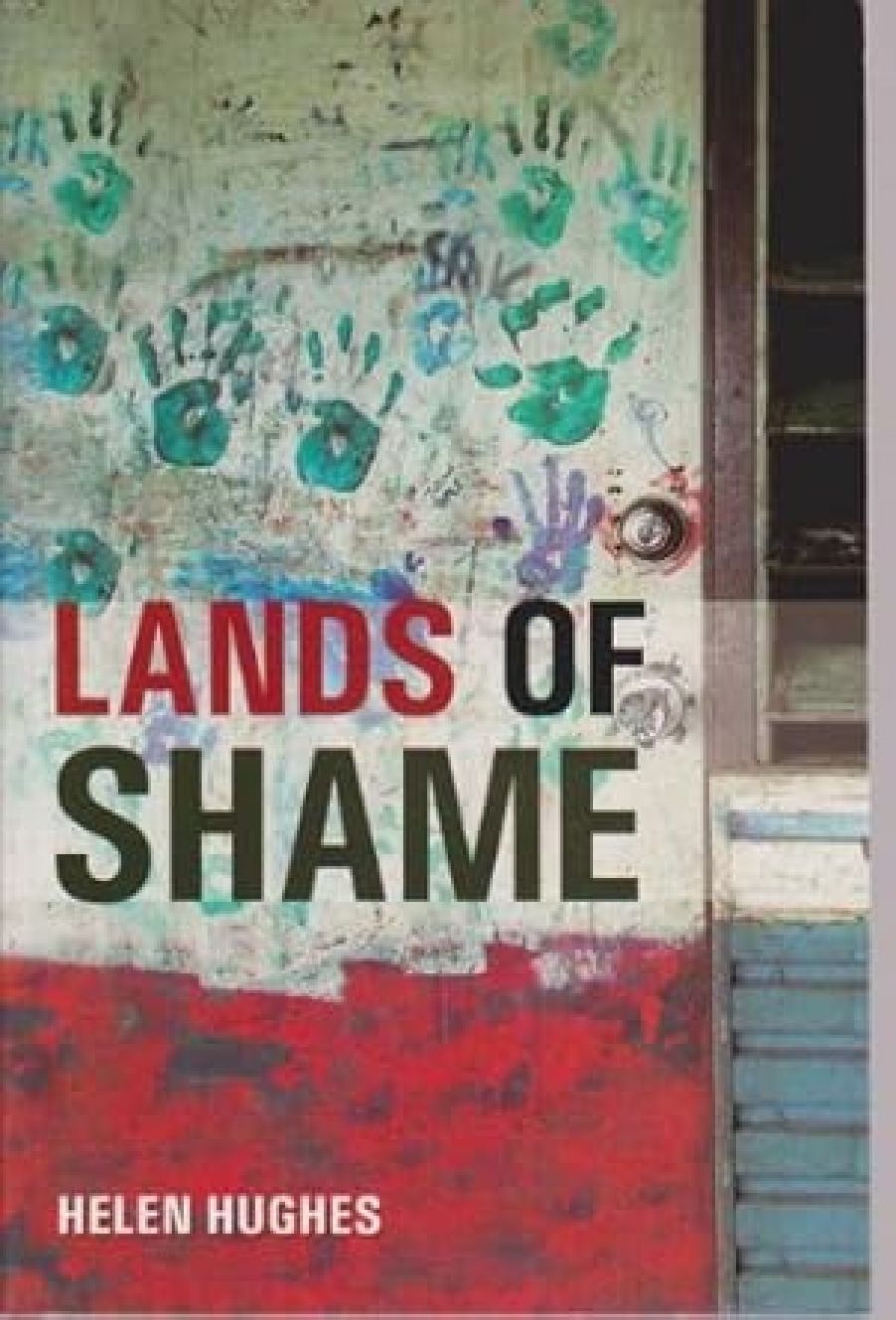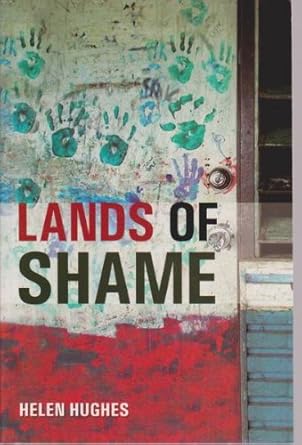
- Free Article: No
- Contents Category: Indigenous Studies
- Review Article: Yes
- Online Only: No
- Custom Highlight Text:
Helen Hughes was a professional development economist who worked at the World Bank from 1968 to 1983 and then, as an academic, headed the National Centre for Development Studies at the Australian National University from 1983 to 1993. Since then, she has been a senior fellow at a conservative think-tank, the Centre for Independent Studies, where she initially focused on issues of development in the Pacific and, since 2004, in remote indigenous Australia.
This book’s launch was timed to coincide with the fortieth anniversary of the 1967 referendum. Hughes sets out to assess and address the ‘Aboriginal problem’ for 90,000 indigenous people who live in some 1200 ‘homeland’ settlements established in remote Australia from the 1970s, according to Hughes. Her book focuses on the ‘homelands’, because, in her view, their occupants’ deprivation is the greatest.
- Book 1 Title: Lands of Shame
- Book 1 Subtitle: Aboriginal and Torres Strait Islander ‘Homelands’ in Transition
- Book 1 Biblio: Centre for Independent Studies, $38 pb, 237 pp
- Book 1 Cover Small (400 x 600):

- Book 1 Cover (800 x 1200):

Hughes’s polemical and angry account goes something like this. The so-called ‘homelands’ (these are always in quotation marks yet never defined) are the product of a socialist ‘homeland’ model devised by her constructed bête noire, economist H.C. (Nugget) Coombs. In these mythical places located on remote Aboriginal-owned lands, there is a high degree of social dysfunction and poor law and order, high welfare dependency, and abysmal health, housing, education and employment outcomes. Much of this is undeniable. The policy reforms proposed by Hughes include privatising and individualising housing and enterprise; moving people to mainstream employment in mining, pastoralism and fruit-picking and away from their ancestral lands; compulsory compliance with mainstream education standards; private, rather than public, housing; a health audit for all, with result provided to families so that they take responsibility; one law for all; better-trained indigenous police; alcohol and kava management; and more. Sound familiar? Much of this looks like the measures incorporated in the federal government’s recent ‘national emergency’ response to child sex abuse in the Northern Territory. If only it were that simple.
Hughe’s analysis is deeply problematic from start to finish. She begins with an idiosyncratic policy history that variably starts either in 1788 or in 1967, with ‘exceptional policies for Indigenous people’. There is no 200 years of policy. But there were policies that were official between 1951 and 1972 called assimilation, and then integration, that do not even rate a mention in this book. Whether this is selective amnesia or just poor scholarship is difficult to judge but these policies certainly blot the script as they were top-down, imposed, draconian and expensive; and they failed to achieve their goal to assimilate indigenous people into the Australian mainstream. Given that Hughes wants to revisit this state project, ignoring its past failure is an unconscionable omission.
Importantly, it was the state’s colonial project of assimilation that resulted in the establishment of government settlements and missions that are what Hughes now terms ‘first tier and second tier core centres’, as well as ‘homelands’. By conflating numerous settlement sizes, from small remote townships to remoter and smaller outstations under the broad rubric ‘homelands’, Hughes conveniently ignores the centralisation practices of colonial administrations that created economically artificial, culturally diverse and socially problematic townships. Decentralisation saw Aboriginal people move back to live in small family-sized groups on their ancestral lands. This occurred first in 1972, when the policy shift from assimilation to self-determination liberated people to escape authoritarian régimes on government settlements and missions. It gathered pace when the land rights law in 1976 gave Aboriginal people legal title to their land. It was indigenous agency that resulted in the outstations movement, not some state or public benevolence or Coombsian manifesto.
On economic and statistical analysis, Hughes, as a distinguished economist, fails dismally. In this she quite blatantly chooses to ignore a cogent argument from economist Boyd Hunter, who, in a paper delivered at the 2005 Conference of Economists (critical of Hughes’s 2004 writings for the CIS) and in her presence, implored her to base her indigenous policy prescriptions on evidence and not on hyperbole. Hughes ignores Hunter’s plea and many of his key published research findings: that indigenous poverty (as measured by household income) is no lower in urban centres than remote regions; that indigenous socio-economic status everywhere in Australia is low; and that there is no evidence that migration from remote to metropolitan Australia will result in improvements. She does this, I believe, because it does not suit her policy script, and therefore perpetuates the myth that migration will fix the problem. Coincidentally, on scholarship, I counted 159 references to the Australian in Hughes’s endnotes, quite clearly her preferred source of expertise. Conversely, Hughes is a doyen of the Australian’s ‘tough love’, heavy intervention, welfare reform editorial mantra – a mutual admiration cabal.
Ideologically and theoretically, Hughes pits her brand of free-market fundamentalism against Coombs’s Keynesian liberalism (not ‘socialism’, as Hughes persistently labels it) that envisaged an important enabling role for the state, increased choice and agency of indigenous people. This manifestation of the ‘culture wars’ is a little belated and unsavoury as Coombs died in 1997 and is in no position to address the charges.
As Coombs’s colleague for a number of years, I can attest that he spent his ‘retirement’ (symbolically from 1967) in a personal social justice quest to enhance national understanding of indigenous rights, cultural distinctiveness and diversity, and heterogeneity of circumstances. His economics approach was marked by a grounded echoing of diverse indigenous aspirations, based on deep consultation and understandings; his proposals were bottom-up.
Hughes is a very different type of economist. She is a cultural difference denialist who also wants to ignore past policy failure – the era of assimilation – while seeking its revisiting today as a champion of the mainstreaming project. She also conveniently ignores state failure to deliver citizenship rights and services to indigenous people on any equitable needs basis (as pointed out time and again in academic and official reports such as the Indigenous Funding Inquiry, published by the Commonwealth Grants Commission in 2001), and so she fails to explain the crucial structural underlying reason for indigenous disadvantage – state neglect. Unlike Coombs, her approach is top-down and ungrounded. Much of her focus is on the three Aboriginal townships of Wadeye, Maningrida and Yirrkala, but she has not visited any of the three, to my knowledge (she declined an invitation to visit Yirrkala in 2005 to discuss her views), and so her prescriptions lack indigenous voices or consultations. She appears comfortable extolling the virtues of the free market for all, irrespective of cultural differences or residential location. Such a doctrinaire and simplistic approach, while currently very much in vogue, will not deliver sustainable development outcomes to indigenous Australians, especially those in the remotest parts of the continent.
The subtitle of Hughes’s book suggests a transition is underway, and this is undeniable: to where remains the crucial question. Like many conservatives, Hughes seems miffed that Australian laws have now returned significant tracts of land and limited property rights to indigenous people in remote regions. Rather than support these hard-won gains as a means to economic empowerment, she wants to change the law to eliminate group ownership and inalienability. Almost begrudgingly, Hughes acknowledges that Aboriginal people living on their land do make contributions in the arts and in natural resource management. Herein, perhaps, lies the alternative to Hughes’s imagined future for remote living indigenous Australians. Since the 1985 Miller Report on Aboriginal Employment and Training Programs, there have been appeals to build the economic base on the indigenous estate. Rather than again seeking to truck people off their ancestral lands, a more constructive approach might be to recognise people’s aspirations to live on the land they own and to engage in diverse sustainable livelihoods in the arts, in provision of municipal and environmental services, biosecurity and border protection, and in new industries such as carbon abatement and in the customary sector. One size will not fit all communities, but a sound developmental participatory approach might see alternate sustainable futures for indigenous people on their ‘homelands’.


Comments powered by CComment